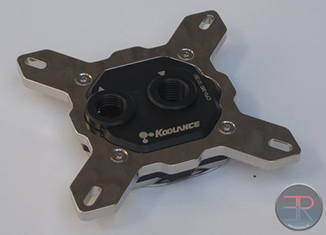First off – a big thanks to the sponsors because without them this never would have happened. If you like reviews like this make sure to support them so that they will support future reviews!
Performance PC’s were generous enough to sponsor six blocks – so big love to them:

Thanks to my other sponsors (in alphabetical order):
DT Waterblocks for sponsoring the 5Noz, Direct and Sniper blocks
Danger Den (sadly now closed) for sponsoring the M6 Block
EK Waterblocks for sponsoring the Supremacy Block
Indigo Xtreme for sponsoring the TIM
Koolance for sponsoring the CPU-370 and CPU-380 Block
MIPS for sponsoring the IceForce HF Block (and Frozen/Aquatuning for getting me it)
Sidewinder Computers for sponsoring the Bitspower Summit HF
Spotswood Computer Cases for sponsoring the tech station
Swiftech for sponsoring the Apogee HD Block and a MCP35X2 pump to enable the measurements vs flow rate!
Test setup:
Motherboard – Rampage IV Extreme – stock heatsink, fan underneath board to avoid VRM throttling
CPU – Intel i7-3930K (Unlapped) @ 4.7GHz 1.45Vcore
RAM – 4x4GB Gskill Trident DDR3 2000-8-9-8-24 1.65V @ 1600-9-9-9-27 1.5V
HD – WD RE4 250GB
Case – Rich Chomiczewski’s Test Bench
Radiator – XSPC EX560
Fans – Gentle Typhoon 120mm 2150rpm in push/pull with BGears 120->140mm adapters
Reservoir – EK 400 Basic
Pump – Swiftech MCP35x2 – PWM controlled by CF635
Temperature Logger – CrystalFontz CF635 USB + SCAB module, probe data logged with WinTest
CPU Core Temp Logger – RealTemp 3.7
Temperature Probes – Dallas DS18B20 “One Wire” Sensors modified to fit inside a Bitspower 3/8” barb
Flow Meter – King Instruments 7520 series 10” 3.5gpm range
Quick disconnects – Koolance VL4N series (4 pairs)
Pump power was kept constant for the MX-2 runs, and it was swept over 7 points for the Indigo Xtreme. The MCP35X2 is a dual pump (in series) but was run at 39% PWM setting for the MX2 runs which roughly corresponds to a single MCP35X running at 100%. I.E. This test is meant to reflect a typical cpu only loop setup with one radiator and one strong pump. If you know your setup is significantly stronger or weaker than this setup then you will want to look at the results with Indigo Xtreme and modify them based on the MX2 to IX delta.
Because ambients were fairly well controlled and because my data was taken multiple times and measured vs coolant temperature rather than vs the ambient temperature then I think my results are about as accurate as you can be without calibrating the cpu temperature sensors themselves. I would estimate that my margin of error is no worse than 0.5C, and therefore averaged data should be a little better than that.
It should be noted that this data is taken on a 3930K and that results may differ significantly for different CPUs with different heat signatures and bows on the IHS.













[…] The CPU block is the Koolance 380 which was the winner in our CPU Block LGA2011 roundup, which you can read about HERE […]
[…] […]
[…] […]
So let me see if I understand, I have a Koolance CPU-380i, in order to obtain the best performance should I put the ports perperdicular to the memory slots (- ||||) or in parallel with the memory slots ( | ||||) ?
the ports should be parallel to ram on SB-E like this pic:
http://koolance.com/image/cache/data/products/cpu-380i_p3-700×700.jpg
(even though this isn’t SB-E, I’ve just started testing on 4770K now)
Have you test it in Ivy Bridge?, Im using the 3770K and I´ve always use my ports perpendicular to ram, I never thought that this could affect performance, do you think it would be the same performance than the haswell 4770K that you start testing?
[…] at CPU blocks on the 4770K. Although we had previously tested blocks on the 3930K during our huge 2012 CPU block roundup we weren’t sure just how well the results would carry over due to the large size difference […]
How much power (in W) does this (CPU – Intel i7-3930K (Unlapped) @ 4.7GHz 1.45Vcore) represent?
Thanks a lot!
[…] our cpu block reviews we often talk about the “rotation” of the block. In the old 2012 roundup we defined the blocks as not rotated or rotated 90 degrees, without really showing evidence of […]
[…] a new CPU block from a manufacturer that already has one of the top performing blocks from our 2012 roundup means that we expected awesome results. We weren’t the only ones – EK warned us to […]
[…] As can be seen the best orientation of the Apogee XL is essentially the same as the older Apogee HD. We only tested one rotation of the Apogee HD because it is a diagonally symmetric block. While there will be slight performance differences in rotation, all four rotations must be tested and that’s just silly. For more details on the Apogee HD it was featured in the 2012 CPU block roundup. […]
[…] announced the long awaited Version 4 of their Heatkiller CPU block. The V3 did very well in our 2012 CPU block roundup despite being quite old still at the time. The official press release isn’t quite ready yet […]
[…] been around for a long long time. In fact it was an older design when we first tested it in our 2012 CPU water block roundup. It did respectably in that roundup given that it was an older design and as newer blocks launched […]
Comments are closed.